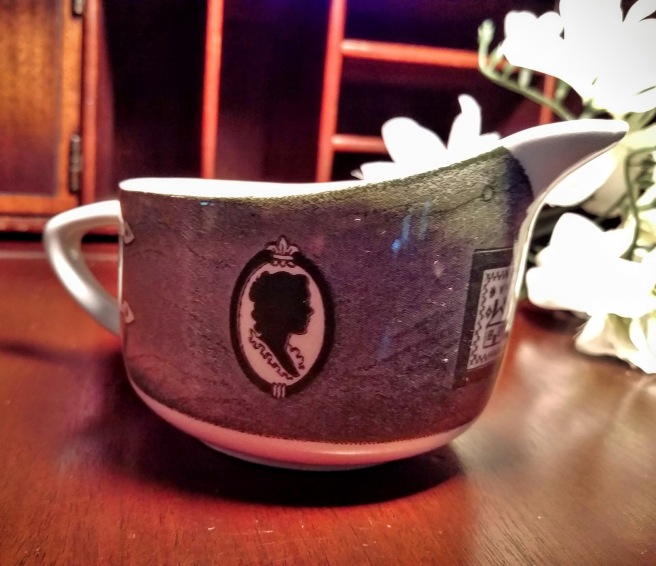I was cruising around one of the local thrift stores I like to poke around in on Wednesday this past week. I tend to linger because as I’m shopping, they keep putting stuff out. So it’s hard to leave because I think I’m going to miss something! I think that is their diabolical plan and it’s totally working.

Well, I was about done after I thought I had seen everything when I spotted the cute creamer above. It was nasty with dirt and grease but in great shape otherwise. It reminded me of my Noni’s house so I couldn’t resist. I brought it home, cleaned it up and put it in the shop. It’s a piece of ceramic ware called transferware.

If you’re not familiar with transferware it’s created by transferring a print from an inked, engraved plate to a sheet of paper which is then applied to the unfired clay. Some sources state the paper is tissue paper. The clay or china, or whatever you are working with, absorbs the ink and after the paper is removed, the piece is then glazed and fired (Collector’s Weekly). Viola, transferware!

It’s an interesting process that started around 1760. I would have thought that that was sort of advanced for the 1700s but they were really doing some innovative things at that time. It began in Staffordshire, England, which, according to Collector’s Weekly has been a center for fine ceramics for a long time.

Transferware allowed the ceramic houses to produce pieces faster than hand painting everything. Wedgwood and Spode were already doing that and doing it well.

Italian scenes and blue-and-white were very popular. Patterns such as Willow became iconic in reference to the art. Collector’s Weekly says that a company called Ridgeway produced a series known as “Old Blue” but was actually called “Beauties of America” in a bid to catch the American market. They depicted important U.S. buildings at the time.

There was a particular glaze technique that sprung up around 1830 called “flown.” It was created by adding lime or ammonia to the kiln during firing the blue-and-white pieces and this made the glaze run or flow. Hence the name “flown.” You can check Collector’s Weekly for some manufacturers of this type of glaze.

Many collectors today tend to collect based on certain attributes of the transfer such as flowers or a particular border. And of course many people collect based on what it is. Some people are into collecting kitchen stuff (ahem, I might know someone who collects these) or some people are into teapots or jugs. Whatever type of transferware you collect, there’s excellent examples out there.

I also happened to find this blog, Nancy’s Daily Dish, that shows the steps of creating transferware in great detail . Check it out, it’s really cool!
Do you collect any transferware or remember it from a parent or grandparent’s house? I’d lover to hear about it. Have a great week!
You can follow me on Bloglovin’ or by email!

Thank you for some history of transferware which is one of my favorite types of vintage pieces!
LikeLiked by 1 person
Thanks, Lisa! They were able to really do some intricate designs I found. The process itself is really cool.
LikeLike
I enjoyed reading your article and learning more about transferware! How fun that you found (and saved) that creamer!
LikeLiked by 1 person
Thanks, JD 🙂 I love the finding and rescuing part of it all!
LikeLike
Really interesting. I like to look at transferware and I didn’t really know the process.
Thanks for sharing.
LikeLiked by 1 person
You’re welcome, Molly! I always wonder who figured out how to do (fill in the blank). Who figured out this process? Interesting!
LikeLike
These are great posts on the vintage ceramics. I’m going to pin them for future reference, thanks so much for the info! Sandi
LikeLiked by 1 person
Thanks! I do love vintage pottery and their backstories. I find out so much interesting information!
LikeLike
I love transferware, Rheta, and always enjoy reading about it. Thanks so much for linking up with Vintage Charm!
LikeLiked by 1 person